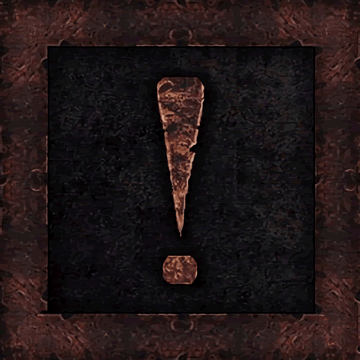When I wrote about the previous Mods and Maps article about Soldier of Fortune, Inc., I honestly wasn’t expecting it to go beyond Quake. When I found it that there were new tie-in levels made for Quake II, it made me replay through Quake II and its expansions, something I hadn’t done in years. I was originally not so fond of it, and I thought maybe a replay would give me a fresh perspective on the game. It didn’t.

(Wouldn't be an id game without some classic monster infighting.)
It’s… fine as a game, I guess. An alright shooter with lots of colored lighting, an uninspired story, and a killer soundtrack by Sonic Mayhem – with contributions by Bill Brown, Jeremiah Sypult and Rob freakin’ Zombie of all people – that just lacked the sort of bizarre mish-mash that Quake did that I enjoyed thoroughly, it just felt rather derivative as a game. Considering how id software was in turmoil at the time, I’m not surprised it feels kinda boilerplate.
While playing those Quake II themed levels for that same article, it dawned on me that despite having written about all kinds of retro FPS stuff for Doom, Quake and Half-Life, I hadn’t written about anything related to Quake II. That changes today, as I look into one of the more deeper cuts of Quake II, released during that wild west period of the early-to-late ‘90s unofficial expansion packs to games.
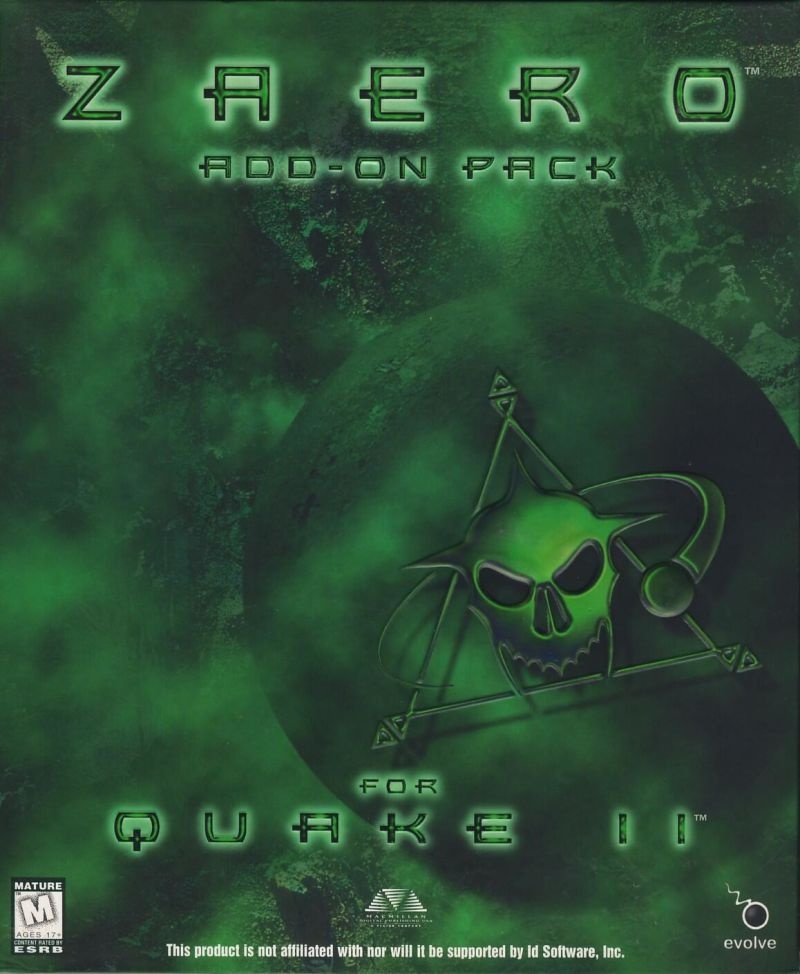
(Good to know it's not supported by id Software, I guess. Cover courtesy of Mobygames.)
Zaero for Quake II is one of the aforementioned unofficial expansion packs. Developed by Team Evolve, this expansion added new levels and weapons to the main Quake II arsenal. But how did this come about? For those who weren’t really around when this was big– and admittedly, I was only tangentially aware of it back then – let’s give a quick refresher course on the shovelware compilation boom.
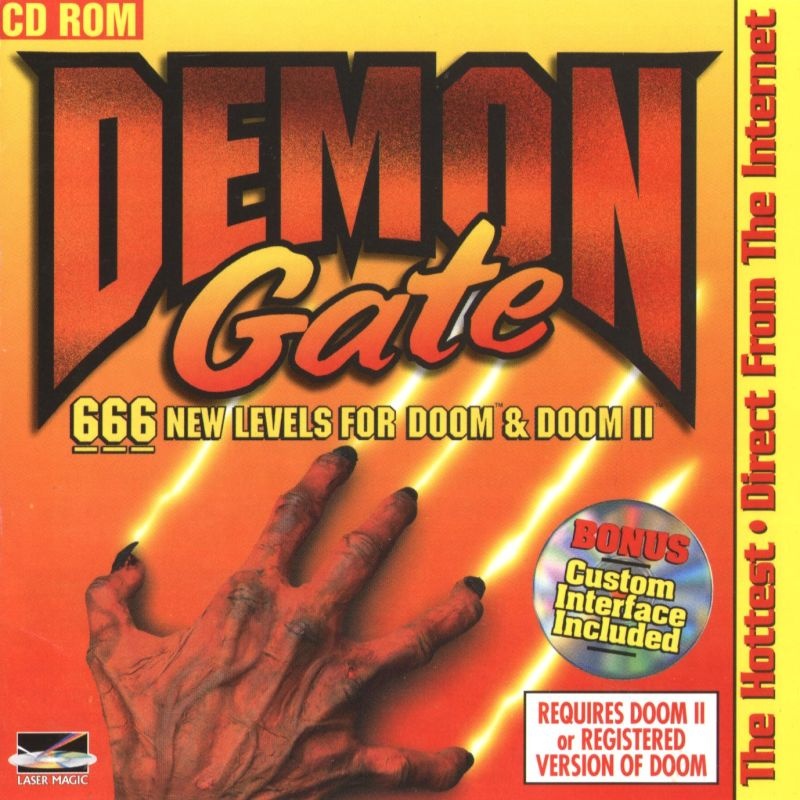
(I get to use this cover again! It's pretty ridiculous, honestly.)
For a period of time, a fair share of shovelware budget publishers such as Softkey and others found a new way to make some easy cash: capitalizing onsome of the biggest game franchises by releasing compilations of levels often downloaded off the still fresh-to-the-world internet, selling them for $20-30 a pop. It was interesting to go to a store and find a compilation of new levels for Doom, which was becoming one of the biggest video game cultural touchstones of the 1990s.
Unfortunately this practice raised the ire of some developers, feeling that those publishers were profiting off the backs of independent hobbyists and budding game designers. At one point id Software themselves decided to respond with The Master Levels for Doom II, a small set of levels made by a handful of the notable members of the Doom community, which came with its own compilation of levels called Maximum Doom.
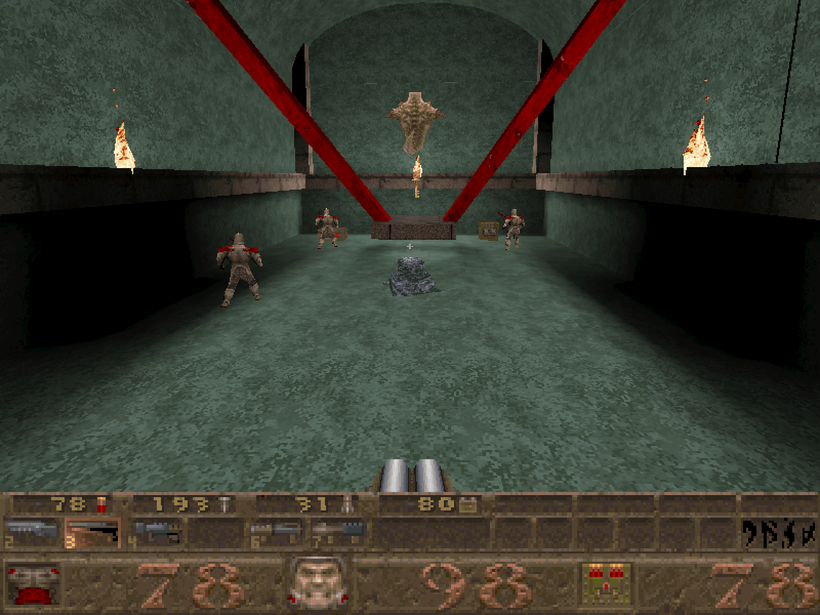
(A screenshot from Aftershock, one of many unofficial expansion packs for Quake 1.)
By the time Quake was released, these publishers pivoted from outright taking levels off the web to contracting people to make more original levels as unofficial expansion packs. I’ve talked about one of these at length before: Aftershock for Quake, which you can read here.
Naturally with Quake II being the Next Big Thing from id software, people capitalized by selling unofficial expansions for that game as well, which competed against both of the official expansions – The Reckoning and Ground Zero, respectively. While none of these were more popular than the official expansions, they did carve a small niche for those who were jonesin’ for more Quake II stuff but didn’t have good enough internet.
Zaero was one of a few unofficial expansions for Quake II, with Juggernaut being the other notable one. I nearly wrote about Juggernaut instead, but the version I seemed to find online was not the final version of the game. Meanwhile the version I found of Zaero seemed content complete, so I opted to write about that one instead.
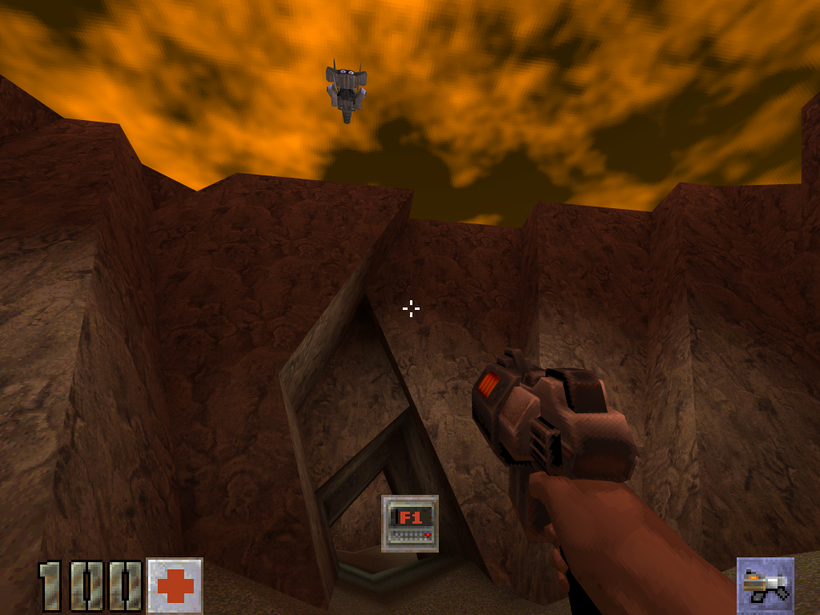
(Looks like I'm doing things all by myself again...)
Taking place after the events of Quake II, you play a marine codenamed “Zaero-1” as they crash land near a mining facility holding a shield generator. With the rest of your squad wiped out, you must fight your way through the planet Stroggos to shut down the shield generator. Quake II had a fairly boilerplate plot, and this unofficial expansion is no exception.
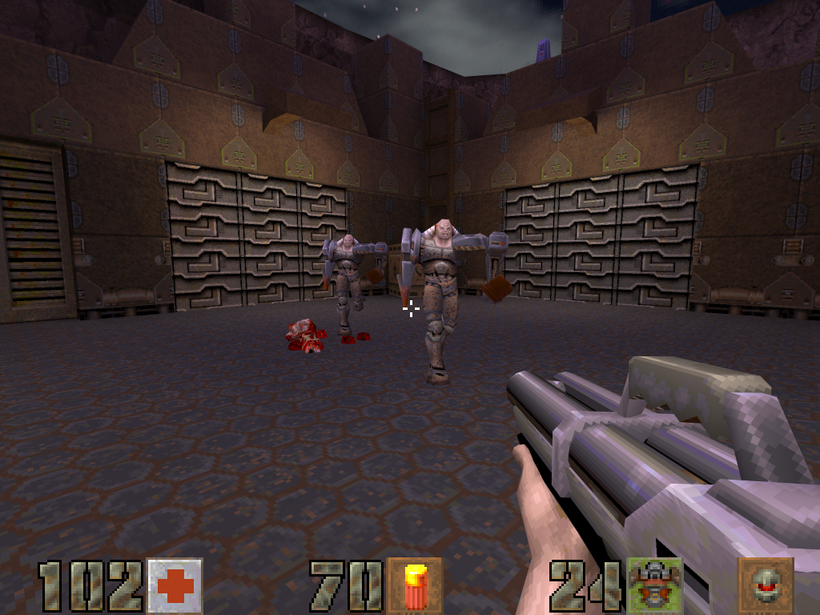
(These berserkers were always a pain, especially in huge numbers.)
A lot of Quake II’s design is driven around completing objectives by murdering everything in your path to find keycards, open doors and make progress. Zaerodoesn’t change a whole lot in this regard, as each area is a hub where you’re given a primary objective and a secondary objective which you’ll usually finish through normal progression. You’ll pick up the standard id software arsenal of shotguns, chainguns, rocket launchers and weapons like the railgun as you blast and gib every Strogg soldier in your way.

(Time to channel my inner assassin. Note: This rendering issue may be an issue with the source port rather than the expansion itself.)
Since this is an expansion, there are new weapons and items exclusive to it. One is a sniper rifle that uses the railgun’s slug ammo that can shoot through certain materials and enemy shields. Another is a powerful “sonic cannon” that uses cells to do mini explosions on enemies, but can blow you up if you charge it up for too long. The game introduced laser tripwire mines like in Duke Nukem 3D or Half-Life, there’s an EMP Nuke that disables energy weapons on enemies, a visor that can let you hack cameras to see what’s ahead of you, and even a deployable energy shield.
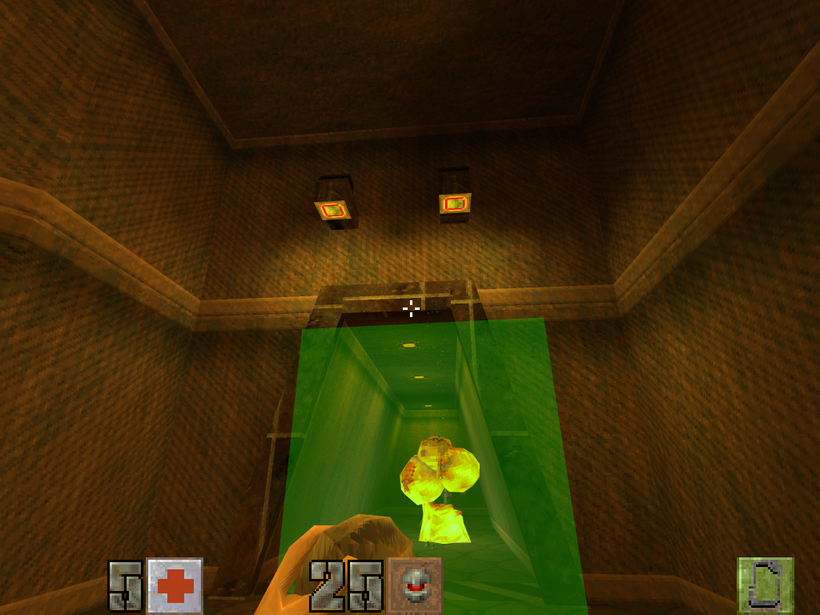
(I guess this makes it easier to take down enemies? Maybe?)
I never saw a major need to use any of the new weapons. In a lot of cases, they didn’t seem as effective as the standard arsenal, which is always the toughest part of introducing new weapons to a game that already has a solid arsenal like Quake II does. That’s the unfortunate conundrum with id software games by this point: The gameplay was honed into a perfect shine, and most additions would often ruin the balance. This is a problem not just in Zaero, but also the official expansions as well.
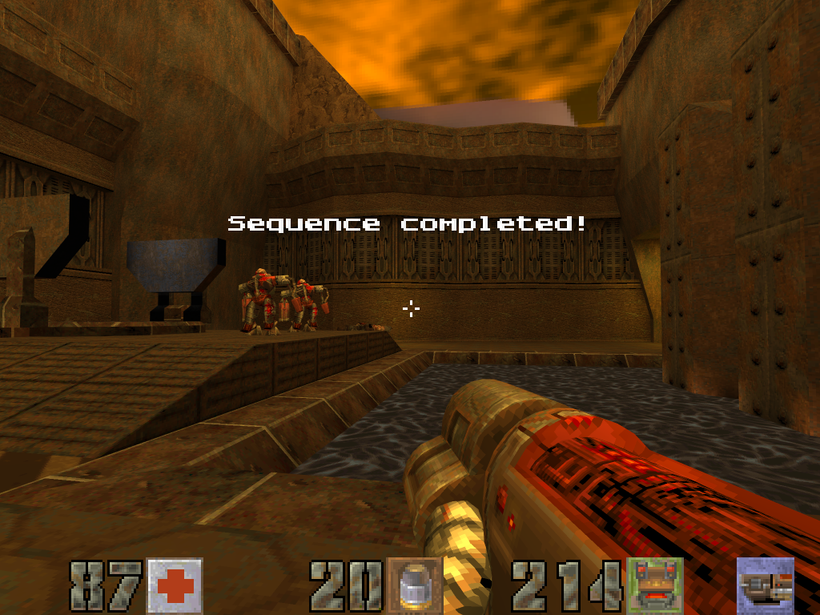
(They may be tanky, but nothing a few railgun slugs can't fix.)
As for enemies, there’s only four new enemies: the alien dog-like hellhound, a handler guard that unleashes said hellhounds on you, and the ridiculously tanky Sentiens, which much like the Tank Commanders in vanilla Quake II require too much ammo to take down and often block critical paths. They’re placed fairly generously around the levels, yet a lot of times I was mostly fighting the standard Quake II enemies more than them.

(They even took a page from Ground Zero and added turrets, which are like the worst enemy type in a game like this!)
The biggest problem this expansion has is that it adds all these sort of elements like the visor and the IRED tripwires that really don’t fit with how Quake II’s gameplay works. Quake II, much like other id software games, is an adrenaline-pumping shooter. They’re not conducive to things like visors, which try to make Quake II more like a tactical shooter. Zaero feels like an expansion made by people who only tangentially understood Quake II’s core mechanics, or tried to take it in a different direction, and failed miserably.
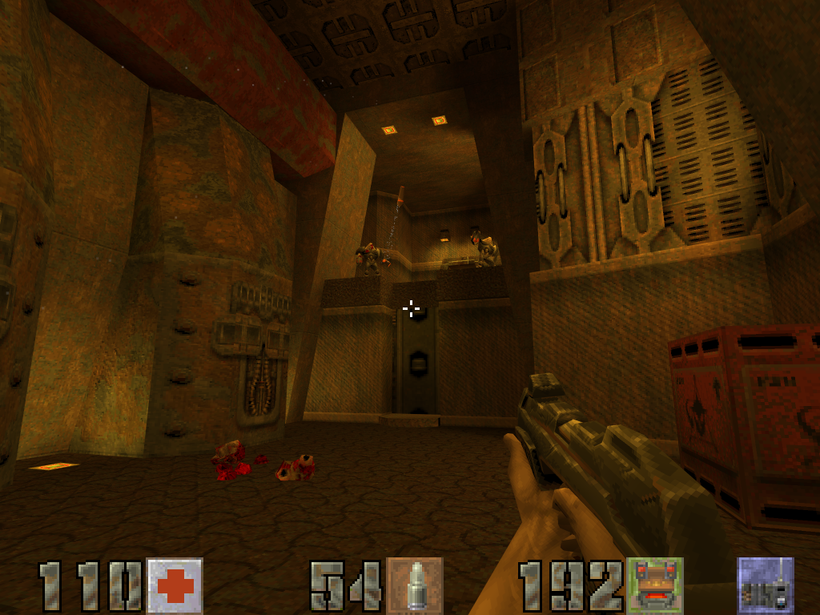
(Yep, they even got the angular trapezoid-like shapes that Quake II did a bunch. They at least did their homework.
As for the levels, they’re alright. I only got lost a few times, but I will say that it’s pretty dirty that something as critical and important as the grenade launcher was locked away towards a secret. My first time playing through this was on “Hard+” – called “Nightmare” in the Yamagi Quake II source port I used to play this expansion – and since I didn’t find the aforementioned secret, I was forced to lob the grenades, which have a longer wind-up time than the grenade launcher, which made fighting enemies an absolute pain, especially when they were in bigger numbers.

(I can't fathom trying to beat this on Nightmare without turning god mode on. It's just not worth it.)
Realizing I didn’t learn from my past mistakes of playing games on the hardest skill level, I bumped it down to Medium and eventually found the grenade launcher secret, which suddenly made the weapon viable in many sections, with the only major hurdle I had was fighting off the game’s bosses.
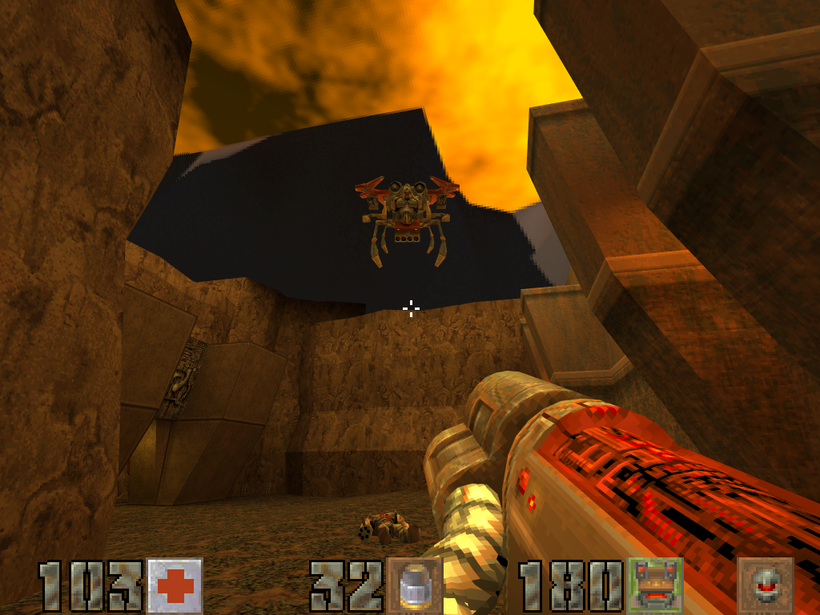
(Hope you like fighting the Hornet again for… some reason.)
One of the more ridiculous design decisions was during the final boss. For some dumb reason, they strip you of all your weapons, forcing you with whatever weapons you can find in the tiny arena the boss is in, where they have powerful weapons and the same EMP bomb that can make most of your weapons useless for a time. Whoever decided this needed to be slapped, as it meant there’s no reason to go hunt down some of the secrets. Indeed, a few levels before the final boss, the BFG10K was hidden in a secret, which felt pointless to find.
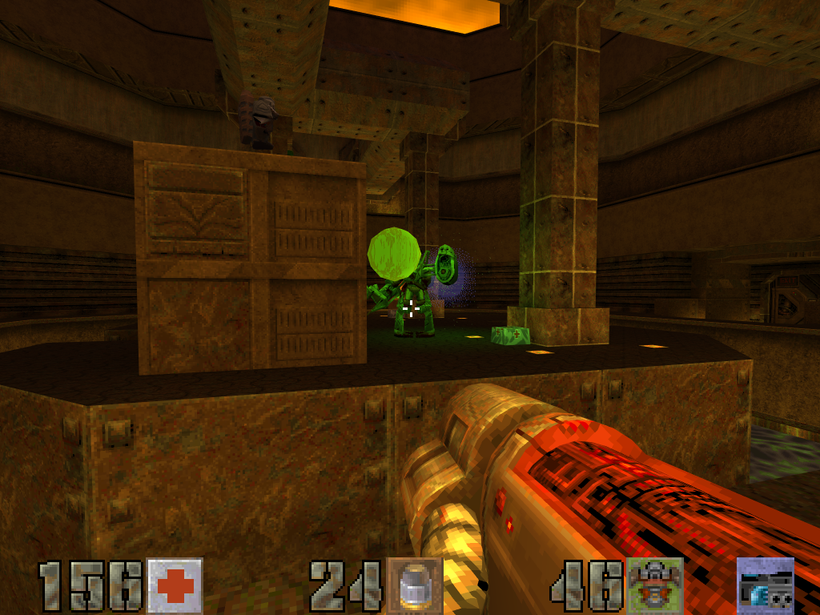
(Of course the big boy also has a fair share of ridiculous overpowered weapons that will one-shot you even at full health. Ridiculous.)
Eventually Zaero-1 destroys the final boss, the shield generator’s destroyed, and your squad comes in to save your butt. The end, roll credits. Maybe hop in and play the deathmatch levels if you wanted to, I guess.

("Where is Isa?" indeed.)
Team Evolve only made two credited games according to Mobygames: this and an unofficial expansion to the 1998 Battlezone game. Most of the people who worked on this stuck around in the games biz for a few years, with a few notable people eventually working at Infinity Ward and Treyarch on the Call of Duty games, and one of the artists for Zaero being one Dhabih Eng, who eventually joined Valve a year after this mod’s release and is still with the company to this day.
To me, this is what I love about writing these games, seeing people who would later go on to work on some of the biggest game franchises in history, were back then a bunch of amateur designers making levels for one of the biggest shooters of the year. It’s pretty neat, honestly.
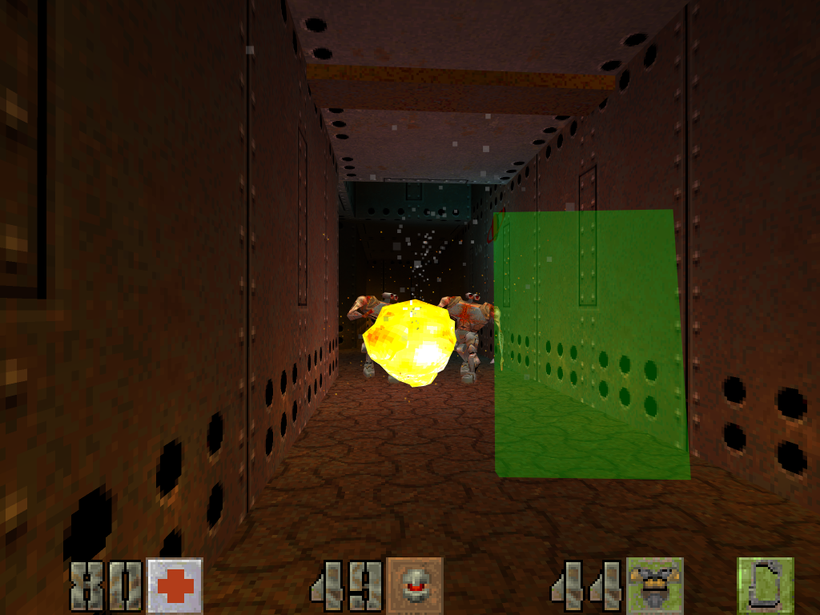
(Never did like these foes.)
As an unofficial expansion, Zaero for Quake II is just More Quake II. Wanted more levels to fight in? Weapons to grab? Enemies to gib? This expansion has you covered. It didn’t set the world on fire, and it became this mostly-forgotten relic of a period of gaming that was slowly dying by the time this came out. I didn’t hate my time playing this, but it certainly just became a forgettable experience to me. It’s worth poking around for a few hours if Quake II’s gameplay style fits your fancy.
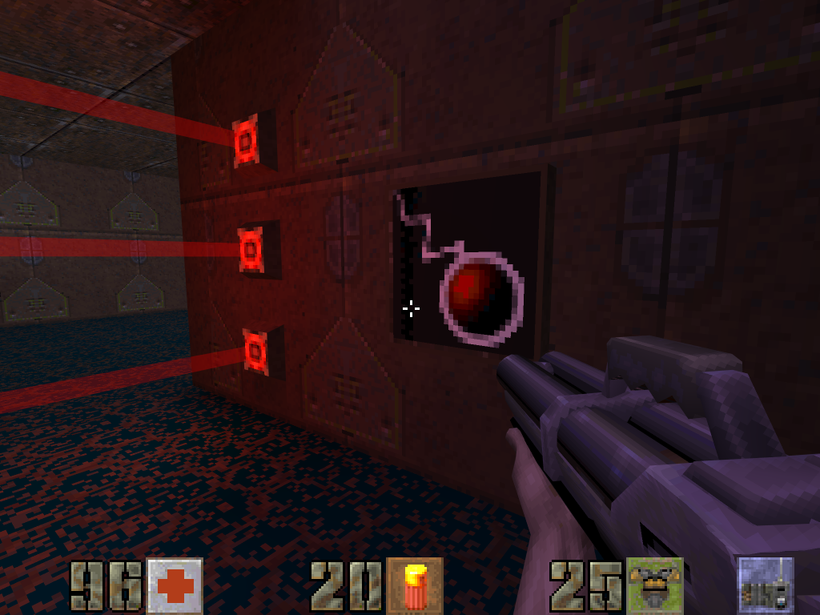
(Their logo shows up on buttons here. And of course, it looks like sperm. Real mature there, folks.)
Zaero was released primarily as a physical product, but there was a demo at the (now-defunct) website. Quake Wiki has a mirror of the site that you can check out if you love 1990s-eraweb design like I do.
If you want to play it these days, there’s always the piracy route. An intrepid archiver posted Zaero on moddb.com, which you can grab here. The expansion is practically abandonware these days, and with both the developer and publisher being mostly defunct, there’s no shame in pirating it. Hell, it’s what I did for this article.
To bring it back to Quake II for a moment: Earlier this year I had read David Kushner’s Masters of Doom, which documents the history of id Software from its founding to the early 2000s, and seeing what was happening around the time of Quake II’s development really hammered home how John Carmack and John Romero were an amazing game development duo. They were like a singer-songwriter duo that split: While they could certainly function and make stuff creatively on their own, they worked better as a pair. Quake II and Daikatana are the result of what happens when the two Johns lead a project solo.
Quake II truly was the start of a new era of id software, where it became the House of Carmack for a while, struggling to find an identity after he left, and eventually recovering with the wonderful 2016 Doom and its mostly positive sequel Doom Eternal. With Quake getting a remaster by Nightdive earlier this year, I wonder if a Quake II remaster is on the horizon for next year, since that game will be celebrating its 25th anniversary. Or maybe they’ll just port Quake II RTX to console instead, just so people can gawk at the shiny textures that ruin the game’s art design. Who knows?
